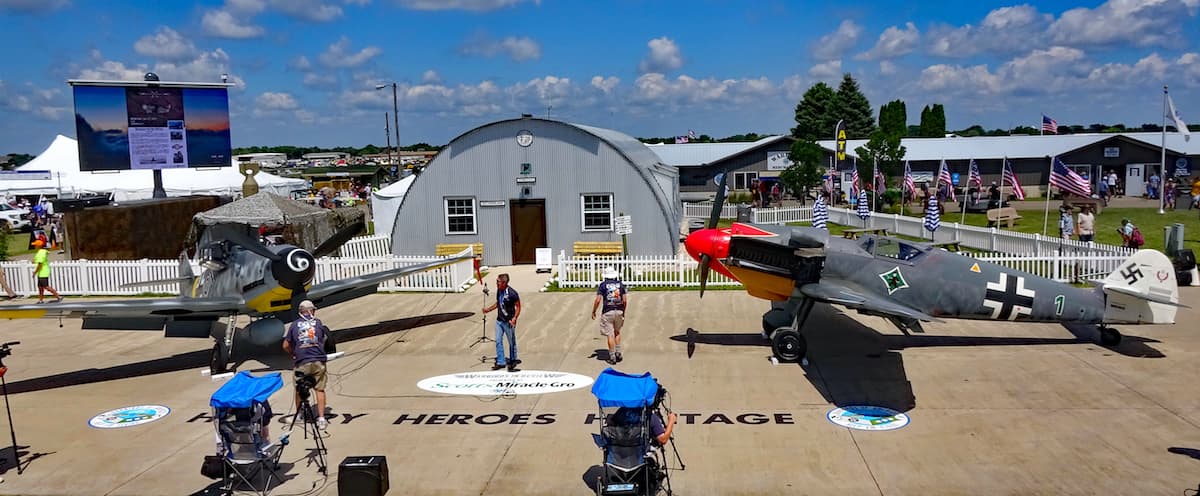Yes, it really is a BF deal… a Bf 109 deal, to be precise.

Two representations of World War II Messerschmitt Bf 109 fighters graced the Warbirds in Review ramp at EAA AirVenture Oshkosh 2022.
Okay, let’s get the nomenclature thing out of the way first. Since this seminal German fighter was produced by Messerschmitt, some accounts (including many wartime U.S. Army Air Forces documents) called it the Me 109. Purists will argue it should be called the Bf 109, for the Bayerische Flugzeugwerke, in which Willy Messerschmitt and Robert Lusser designed the fighter.
Many German documents refer to it as the Bf instead of the Me. When Bayerische Flugzeugwerke became the Messerschmitt company, later aircraft bore the Me designator, and the ‘109 fighter was caught in a storm only a nomenclature freak would engage.
Me or Bf, the two menacing-looking machines parked on the Warbirds ramp at Oshkosh said a lot about the hostile world in which Allied fliers entered combat over Europe and North Africa more than three-quarters of a century ago.
With about 33,000 Bf 109s constructed before and during World War II, this heavily-produced fighter suffered heavy combat losses and was rapidly scrapped once the fighting stopped.
Original German Bf 109s are a rare commodity, and the presence of Bruce Winter’s German Bf 109G-6 at AirVenture was a triumph of refurbishing by Midwest Aero Restorations of Danville, Illinois. This startlingly realistic fighter was named Grand Champion in the Warbirds category at AirVenture 2022.

And a second ‘109 flew to Oshkosh this year, a clever reworking of a Spanish license-built variant. Hispano HA-1112-M1L Buchon fighters were manufactured in the mid-1950s, incorporating a Bf 109 airframe mated awkwardly to a Merlin V-12 engine driving a four-blade propeller. If the Buchon was a mess in the aesthetics department, it nonetheless kept airframes around long after most had gone to the chopper.
The 1969 movie, “Battle of Britain,” famously used a fleet of surplus Spanish Buchons to play the bad guys, and Buchons have adopted German paint and markings ever since.

Part of the Erickson Aircraft Collection, which is based in Madras, Oregon, this HA-1112 traded its Merlin powerplant for a readily serviceable American Allison V-1710 engine in a custom mount that put the thrust line where it was on German models.
Exhaust stack extensions, hidden under an original German Messerschmitt cowling, drop the visible exhaust ports to a location that handily mimics the look of an original inverted V-12 Daimler Benz engine when the cowling is buttoned up.

The beautified Buchon received a Judges Choice Award for foreign fighters at Oshkosh.
The crowd filling the bleachers in the Warbirds area for the review of the Bf 109s included those who understood the rare opportunity of the moment.
Years ago, warplane aficionados despaired of ever seeing a Bf 109 — especially a genuine German example — in flying condition. To have two airworthy representations of this scourge of the skies parked nose-to-nose at AirVenture was so Oshkosh.

Winter’s German Bf 109G was raised from a lake in Estonia in the 1990s. He acquired the machine in 2012, and a decade-long restoration culminated in its presence at AirVenture.
Its Daimler-Benz DB 605A inverted V-12 engine was rebuilt by Mike Nixon’s Vintage V-12s in Tehachapi, California. With a displacement of 2,100 cubic inches, the big German engine burns about 70 gallons per hour. The slightly smaller Allison in the Erickson Bf 109 runs at about 60 gallons per hour.
The Bf 109 was designed with the main landing gear attached to the fuselage, and splayed outboard to give the fighter a reasonably wide track.
Yet this design has been criticized by some as difficult to land and that shade has followed the Bf 109.
But recent Bf 109 pilots Bruce Winter and Erickson’s Doug Griffin had positive things to say about their Messerschmitts.
“I absolutely love this airplane,” Griffin told the crowd at AirVenture, adding his flying in the fighter so far is “quite enjoyable.”
And if there is a tip for keeping the ‘109 under control on landing, Griffin said, “I would not wheel land this airplane.”
So three-point touchdowns it is.

Winter added Messerschmitt would not have built 33,000 Bf 109s “if it’s just an animal” to control.
The accomplishments of warbird owners and restorers like Midwest Aero and Erickson continue to astonish warbird enthusiasts and raise the bar for future efforts.

I saw Gunther Rall speak at Oshkosh the year he passed away.I often thought about how great It would have been to have had a real 109 parked behind him.My jaw literally dropped when I saw those two last year.Thank you to the owners for putting these two great warbirds back in the air.
Love the headline.
I couldn’t believe what I was looking at!
It was absolutely stunning to see up close and personal!
I’m just amazed at the time, effort and resources involved in this effort to preserve such a historic aircraft! Thank you doesn’t seem strong enough but thank you, thank you, thank you!!!